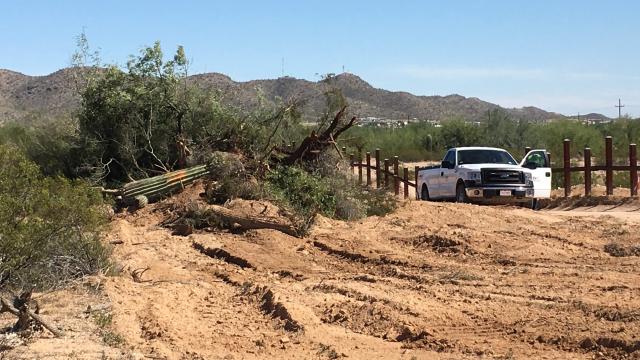The Trump administration has run roughshod over American environmental laws in a rush to build an unnecessary border wall. And in footage that emerged on Saturday, construction efforts are just running roughshod over the environment, period.
One of the first stretches of the Trumpified wall is going up in Organ Pipe Cactus National Monument (yes, they really chose a park as a starting point). Video shot by Kevin Dahl, the senior program manager for the National Parks Conservation Association in Arizona, shows construction crew toppling saguaros in their rush to prepare the site for wall construction.
VIDEO: Saguaros are being bulldozed for the #BorderWall in Organ Pipe Cactus National Monument. Trump’s reckless border hysteria is destroying our environment and killing the very species this national monument was designated to protect.
Footage by Kevin Dahl, @NPCA. pic.twitter.com/XceszFIRKd
— Laiken Jordahl (@LaikenJordahl) October 4, 2019
Dahl told Gizmodo bulldozers were busy knocking down saguaros and other desert plants and piling them up into slash piles when he visited the park on Tuesday. The destruction took place on the west side of the park in preparation for construction to begin there on a 125km chunk of Trump’s wall.
Organ Pipe, which runs directly up against Mexico and sits about two hours west of Tucson, already has a variety of barriers in place. They include five miles of fence to keep pedestrians out and another 40km of posts that act as vehicle barriers. The latter are visible in the background of the videos and photos Dahl shared with Gizmodo.
The cactus you drew all the time when you were a little kid? You know, the one with three arms reaching to the sky? Yeah, that’s what they’re bulldozing in the desert right now so the land can instead be covered with a 9 metre tall steel beam wall.
The saguaro defines the Southern Arizona landscape. The stately cacti can grow more than three arms — the biggest of which can weigh upwards of six tons — live 150-175 years on average, according to the National Park Service.
Despite their prickly appearance, they even sprout flowers that provide a bounty of nectar for desert creatures, including the endangered lesser long-nosed bat that calls Organ Pipe Cactus National Monument home. And of course, they’re a cornerstone for the people who live in the desert or dream of it, too.
“We love these saguaros,” Dahl told Gizmodo. “The Tohomo O’odham [tribe], in their taxonomy of life saguaros are very close to humans. And you know, they have a majestic presence, they are the iconic symbol of this part of the world. You know you’re someplace different when you’re in a saguaro forest.”
What happens to the piles of dead brush is anyone’s guess. The Army Corps of Engineers released a video last month saying that the agency would relocate saguaros along with organ pipe, ocotillo, and other types of cacti out of the wall construction site. The video says the agency is “taking great care to take care of the protected species.”
The irony is that in a park, all species are generally protected. The U.S. Organic Act of 1916, which resulted in the creation of the American National Park Service, states that the agency exists to “conserve the scenery and the natural and historic objects and the wild life therein and to provide for the enjoyment of the same in such manner and by such means as will leave them unimpaired for the enjoyment of future generations.” I don’t think mowing down saguaros inside a park’s boundary was quite what the act’s authors had in mind.
That said, there is, of course, some legal wiggle room here. The government has access to what’s called a Roosevelt Reservation, an 18 metre strip of land along the border it can manage for border protection. The saguaros being knocked down are technically within that strip. But even still, under normal circumstances, the actions there would be governed by U.S. laws that include environmental protections and reviews.
In the case of the wall being built by the Trump administration, many of those reviews have been waived because Trump declared a bullshit national American emergency to fast-track construction.
For Dahl, who has been visiting Organ Pipe and the other parks of Southern Arizona for decades (to say nothing of the millions of others who enjoy the region’s protected landscapes), the whole process is a slap in the face. But happening upon the real-time destruction taking place at the border was a whole new experience for him.
“Outrage,” he said, “that’s the appropriate emotion.”
